
2016 – Winners of the 12th Annual Archie League Medal of Safety Awards, honored on March 23, 2016 at Bally’s in Las Vegas:
Alaskan Region: Ron Sparks and Mike Thomas, Anchorage Center
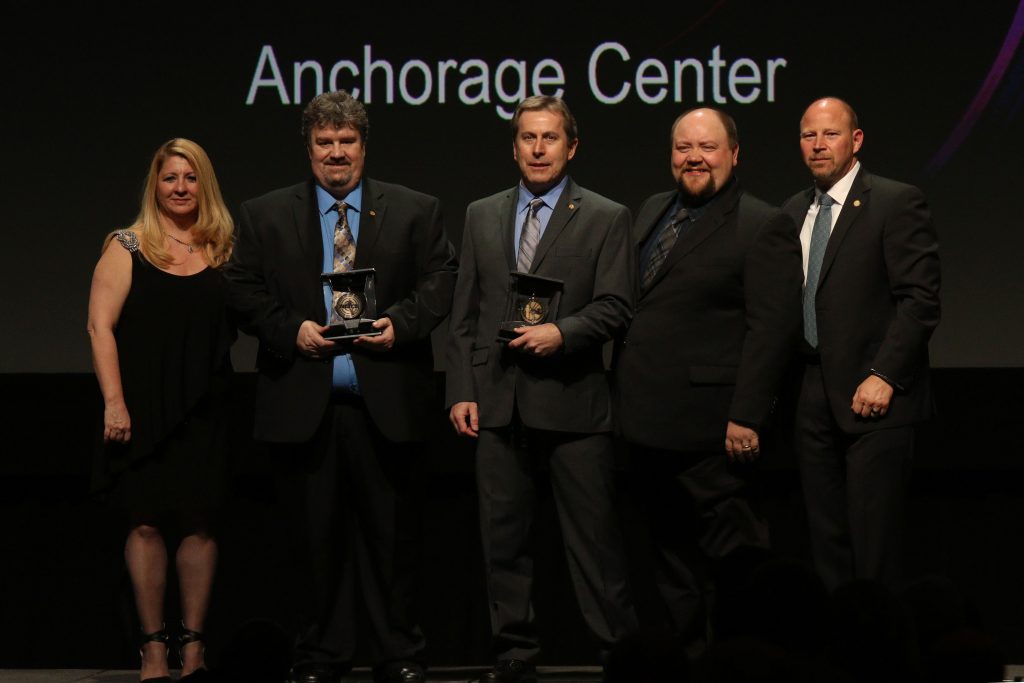
On Nov. 30, 2015, 30-year air traffic control veteran Ronald Sparks and 26-year veteran Mike Thomas were on position at Anchorage Center (ZAN), when a Falcon 10 flew into their sector on its way to Nome, Alaska (OME). The pilot was attempting to land at Nome but a low cloud ceiling and limited visibility began to affect his ability to fly the aircraft. After his first failed attempt to land, Sparks and Thomas got him back on track for a second attempt. But after the second landing attempt also failed, the pilot requested information for nearby airports that had less challenging flight conditions.
Working together, Sparks and Thomas found an alternative airport – Unalakleet (UNK) – about 100 miles to the east, and began vectoring the aircraft there. While en route to UNK, the pilot became nervous about the change in direction because of his lack of familiarity with the area. He wanted to turn back and try OME again, though he was running low on fuel. Both Sparks and Thomas knew that at that point, the aircraft would not make it back to Nome with the fuel he had on board and the current weather conditions. They encouraged him to continue on to UNK. They wanted to prevent the pilot from getting stranded and running out of options in dangerous weather as the conditions at OME continued to worsen.
N256V: We’re on minimum fuel right now. We’re um, yeah I think we want to try again in Nome.
Sparks: Ok I understand you want to do Nome? And it’s uh, the weather is a lot worse now. It’s a quarter mile snow, freezing fog sir. Runway 2-8 RVR eighteen-hundred variable to four-thousand.
N256V: Roger, we will try the Papa Alpha Uniform November (Unalakleet) airport and uh we are climbing to seven-thousand.
When the pilot reached UNK, he realized he did not have the appropriate plates for the airport and could not land there. He also realized he had little fuel left.
Sparks: N256V, how much fuel in time do you have?
N256V: We have maybe 15 minutes.
Sparks: N256V Roger. And how many souls on board?
N256V: Three.
Sparks and Thomas determined that although he did not have the plates for UNK, he did have the full database for the airport. They provided the additional information the pilot needed to land, including updated weather conditions, approach options, and locator information. After over an hour of constant communications with Sparks and Thomas, the pilot landed successfully with just six minutes of fuel remaining.
Alaskan RVP Clint Lancaster:
This flight assist is a testament to the professionalism of Sparky and Mike, and the value a combined 56 years of Alaska air traffic control experience can bring to an emergency situation. I cannot overstate the importance of their calm, consistent, and steady direction to the pilot for nearly an hour-and-a-half. Sparky and Mike used their extensive knowledge of the area and Alaskan weather trends to help the pilot of N256V make a potentially life-saving decision, despite it being counter to what the pilot intended to do.
BELOW: Watch the award presentation.
BELOW: Watch and listen to highlights from this save event.
Central Region: Liam Keeney and Brett Rolofson, Kansas City Center
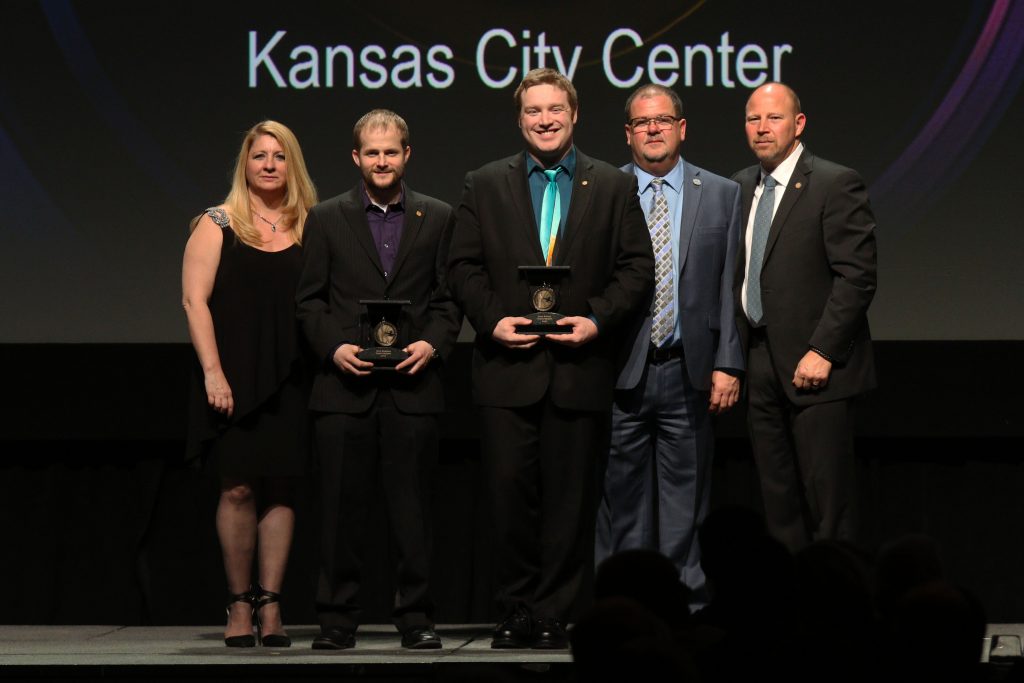
Kansas City Center (ZKC) controller Brett Rolofson was training Liam Keeney on June 15, 2015, when a single-engine Mooney came onto their radar. It was on a visual flight rules (VFR) flight and receiving flight following from ZKC. The pilot was en route to Lee’s Summit, Mo. (LXT), when his aircraft experienced an oil pressure failure. The pilot requested a route change to land at a closer airport to accommodate the failure. The pilot located nearby Perryton Ochiltree County Airport, Texas (PYX), and asked Keeney to relay weather conditions. Keeney realized that the weather at PYX was instrument flight rules (IFR) and that the pilot would likely not be able to land there either. Keeney then suggested Liberal Airport (LBL) because of its better weather.
Rolofson took over Keeney’s position while Keeney began moving some of the traffic on Rolofson’s frequency to his own. That way, Rolofson could focus on the emergency at hand. Shortly after, the pilot relayed to Rolofson that his aircraft could not make the distance to LBL, so Rolofson and Keeney recommended a closer alternative.
Rolofson: N345TM you think you’ll be able to make it 3-0 miles to the Liberal Airport? It’ll be about a 310 heading at this time.
N345TM: Is it thirty-five miles away?
Rolofson: Yeah, thirty-five miles away. N345TM if you need it there is an airport just north of you. It’ll be about a 360 heading. It is called, N345TM, Beaver Airport is Kilo Four Four. It’s currently about a 355 heading eleven miles to your north.
N345TM: Yeah I’m going to try that one because my oil pressure is way down right now.
As he was relaying information for Beaver Airport (K44), Rolofson lost radar and radio contact with the pilot due to the aircraft’s altitude. Rolofson decided to ask American Eagle flight Envoy 3315 to attempt to contact the pilot. Envoy 3315 was able to reach the distressed pilot over their radio. Rolofson began to relay clearances and information to and from N345TM through the pilot of Envoy 3315.
Rolofson: Envoy 3315, Kansas City Center, can you broadcast for N345TM on this frequency? He might be in an emergency situation. We’re trying to get ahold of him and make sure he has an airport in sight.
Envoy 3315: N345TM?
Rolofson: Yep, see if he can hear you.
Envoy 3315: This is Envoy 3315 looking for N345TM can you hear me?
Rolofson had the pilot of Envoy 3315 ask the pilot of N345TM to switch over to an emergency frequency to confirm that N345TM had all of the information he needed to land safely. After several minutes, the distressed pilot of N345TM was able to report through the pilot of Envoy 3315 that he had landed safely at K44.
Central RVP Kevin Peterson:
The calmness, dedication to detail, and teamwork displayed by Brett and Liam was outstanding. Liam taking over all other aircraft on Brett’s frequency gave Brett the ability to focus on the emergency at hand. He was able to re-establish contact with the distressed pilot of N345TM, and ensure through any means necessary that the pilot received the information he needed to land safely. Without this kind of quick thinking, the outcome could have been very different. These two individuals displayed top-notch professionalism and skill.
BELOW: Watch the award presentation.
BELOW: Watch and listen to highlights from this save event.
Eastern Region: Jeff Schuler, New York TRACON
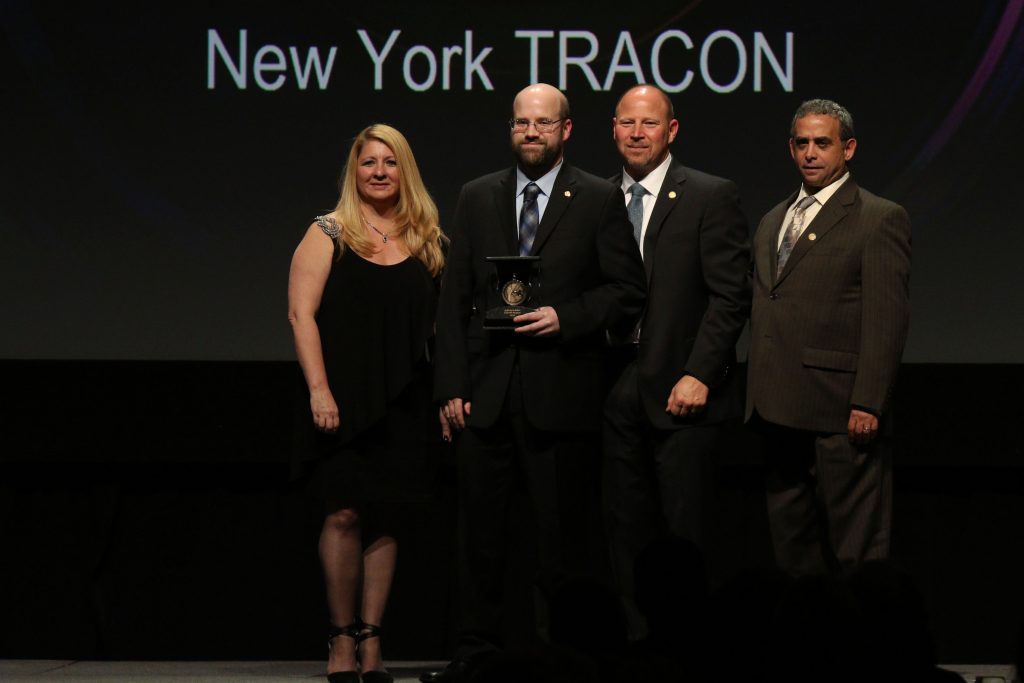
On Dec. 22, 2015, an apparently disoriented Instrument Flight Rules (IFR) pilot of a Mooney descended well below the minimum safe altitude. He dropped as low as 700 feet, quickly climbing back up to 1,800 feet, then descending again to 800 feet, just nine miles from Islip Airport (ISP). Two radio towers stood 643 feet and 821 feet high nearby as the pilot struggled to maintain altitude. The pilot advised that he was having difficulty holding his altitude or flying the assigned headings issued by controllers due to turbulence, wind, and rain.
New York TRACON (N90) took over control of the aircraft and gave the pilot no-gyro vector, but he was confused by the instructions. At this point, N90 air traffic controller and licensed pilot Jeffrey Schuler began handling the flight. Schuler was able to keep the pilot calm, and after again checking local weather, he decided that the best option was for the pilot to land his aircraft at Stewart Airport (SWF). Schuler cleared the pilot to land at SWF, but the aircraft flew opposite to the instructions, at times circling and losing altitude.
Schuler: Are you still in the clouds?
N9525M: Yeah, I’m still here. I think one of my problems is the main GPS I’m following is totally wrong.
Schuler: OK, tell you what N9525M. Just level your wings, level the aircraft, and we’ll start from there OK?
The decision was made to move all other aircraft on the Mooney’s frequency onto another frequency so Schuler could concentrate solely on the emergency at hand. Schuler continuously asked the pilot about the aircraft’s fuel status and received the response that fuel levels were fine. Yet every time the aircraft turned south with strong headwinds, the aircraft showed a speed of only 40 knots in Schuler’s radar data block.
Then, the pilot reported that he’d lost an engine. Schuler convinced him fly to Sikorsky Memorial Airport (BDR), over which he had been circling at 5,000 feet. The only approach aligned for Runway 29 was with the use of GPS. Schuler did not believe the pilot’s GPS equipment – an iPad on low battery – was reliable, so he gave vectors to the pilot for the VOR approach to runway 29. The pilot was continuously turning his aircraft in the wrong direction and descending on his own because of the distraction of his failing GPS.
N9525M: Yeah, I’ve got about another 10 percent on this iPad then I have no GPS left in this plane.
Schuler: Forget the GPS. Level your wings. Fly the aircraft. Do that first.
Schuler was able to focus the pilot and direct his descent into BDR. The pilot broke out of the clouds at approximately 600 feet above ground level as ATC was losing radar contact with him. The pilot was able to safely make a circling approach to Runway 29.
Eastern RVP Dean Iacopelli:
Jeff is the first NATCA member from New York TRACON to win an Archie League Award! The professionalism and calm approach he displayed throughout this event is a reflection of not only his expertise, but of our profession overall. We have the finest, most dedicated professionals in the world operating the safest and most efficient air traffic control system in the world. Without his expert guidance, the pilot may have been too distracted to make a safe landing. I’m proud to represent Jeff as a member of the Eastern Region, and as a member of our great Union.
BELOW: Watch the award presentation.
BELOW: Watch and listen to highlights from this save event.
Great Lakes Region: David Kilgus, Columbus Tower/TRACON
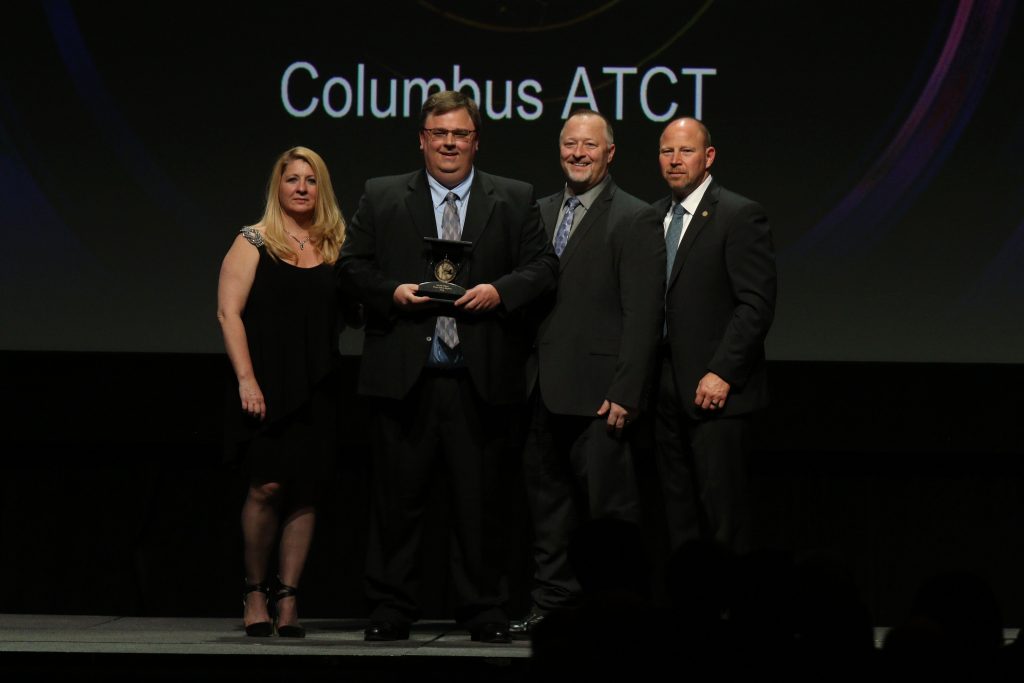
David Kilgus plugged in on position on March 10, 2015, and began working a Piper Comanche. The pilot was flying to CMH after starting his long journey in Guatemala. He had been in the air all day. Weather in the area was instrument flight rules (IFR) with a 200-foot cloud ceiling and a half-mile of visibility. Kilgus began vectoring the pilot to instrument landing system (ILS) runway 10R at CMH, but he was having a hard time understanding his instructions. English was not the pilot’s first language, and the difficult flying conditions, combined with the lengthy flight, made that barrier even harder for him to overcome.
Suddenly, the pilot made a hard right turn towards final approach without instruction, directly into oncoming inbound traffic. Kilgus immediately caught the pilot’s error and issued him a hard right turn away from traffic to get the pilot back on track. Kilgus then began vectoring the aircraft towards Runway 10R for a second landing attempt.
The pilot had difficulty maintaining the ILS and his altitude and flight course did not line up with the required final approach. Kilgus continuously gave corrections as well as the ILS frequency, after which the pilot asked Kilgus to “keep an eye on me.” It soon became apparent the pilot could not make the approach into CMH due to his inability to navigate the ILS approach. Kilgus decided to offer the pilot the location of nearby satellite airport, Rickenbacker International (LCK). LCK had reported better weather than CMH. The pilot accepted this suggestion and was given short-range clearance and a weather report by air traffic control. The pilot of was still having difficulty navigating this new approach and was constantly setting off low altitude warnings.
Kilgus: N914DP low altitude alert. Maintain two-thousand five-hundred until established localizer. Looks like you’re going through it.
Kilgus: N4DP, Columbus.
N914DP: Yes sir, yes sir. I’m trying to get here on the localizer sir.
Kilgus: N4DP you’re low, two-thousand one-hundred. Verify you’re on the localizer and the glide slope.
After a failed first approach into LCK, the pilot reported he had run out of fuel.
N914DP: Sir, I just run out of gas. I think I ran out of gas.
Kilgus: OK N4DP, roger. Present heading, Rickenbacker is 12 o’clock in four miles. Fly heading is 0-5-0. 0-5-0 heading.
N914DP: I think we are on priority fuel right now sir.
Kilgus relayed to the pilot the distance to LCK, and after a few intense seconds, the pilot reported that he was able to transfer fuel from his other tank. Kilgus was then able to safely work him into LCK airport, all while he continued handling other air traffic on final approach into CMH. Not wanting to have the pilot of the Comanche make any unnecessary frequency changes, Kilgus took responsibility to work the aircraft, possibly saving the pilot’s life.
Great Lakes RVP Bryan Zilonis:
The fantastic work done by David to assist N914DP is a testament to his skill and ability to remain calm under pressure. His patience and consistent direction to a pilot through three landing attempts shows the highest standard of dedication to safety and this profession. The pilot was so grateful to David for his assistance that he took the time to call Columbus later that day to thank the air traffic controller who helped him. Events like this one make me even more proud to represent all of the great air traffic controllers from the Great Lakes Region.
BELOW: Watch the award presentation.
BELOW: Watch and listen to highlights from this save event.
BELOW: Media coverage from CBS Columbus.
New England Region: Joseph White, Providence Tower
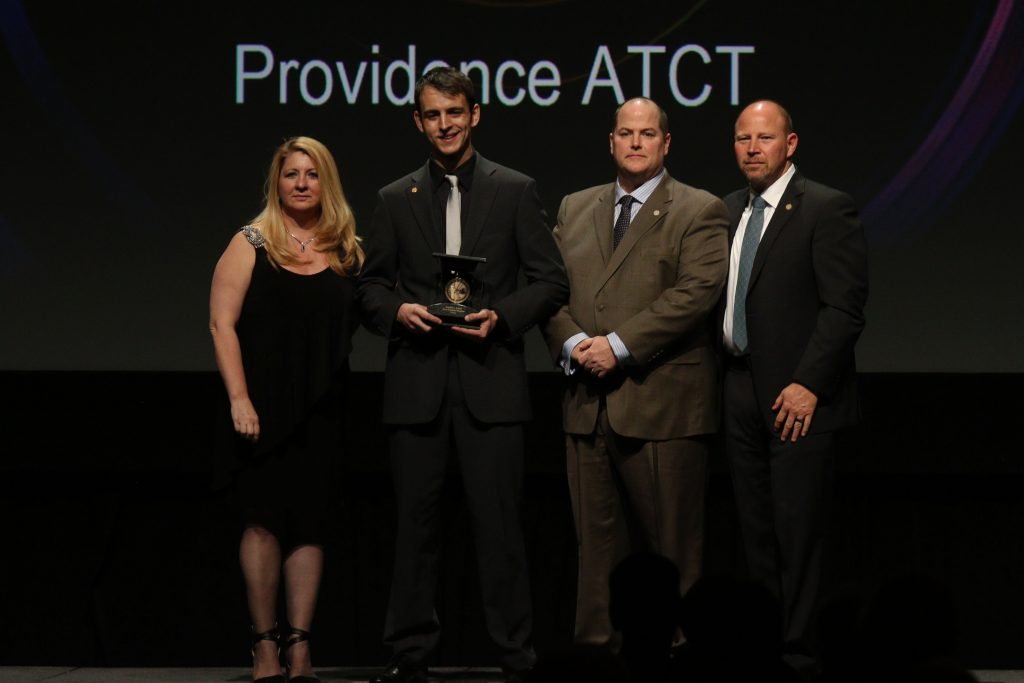
On April 20, 2015, the pilot of a Mooney M20K was experiencing a gear malfunction. Joseph White was on position at PVD and began assisting the pilot, who was having a hard time staying calm. White told him, “It’s OK, we’re going to work with you on this,” and took control. Adding to the difficult situation, the airport surveillance radar antenna (ASR-9) at PVD was out of service, which prevented radar contact with aircraft below 2,000 feet in the vicinity of the airport. At that time, coordination with another scope was established to help White track the aircraft by using long-range radar (LRR). This helped White identify the aircraft’s location at low altitudes.
White: N73S we have a radar mode that will give us radar to about two-thousand feet so what we’re going to try to do is keep radar that way and get you down to two-thousand and try to get the field in sight for you.
White: N73S when able say fuel remaining and souls on board.
N5773S: Just one soul on board, 73S.
There were low cloud ceilings and IFR conditions that day. The pilot reported that in addition to the aircraft’s gear malfunction, the trims, GPS, and autopilot were inoperative. White attempted to vector the aircraft towards the airport for nearly 40 minutes, then initiated no-gyro vectors for ILS Runway 5 at PVD. The pilot was unable to intercept the localizer, so White advised the pilot to descend to 1,200 feet — well below the minimum vectoring altitude in that area.
Because of this lower altitude, the pilot was able to break through the low cloud ceiling. He wanted to attempt a visual approach into the airport and reported that he had the airport in sight. Unfortunately, he had mistakenly identified Quonset (OQU) airport visually, not Providence.
White: N73S roger. Proceed visually for Providence Airport Runway 5.
N5773S: Visually to Runway 5, 73S.
White: N73S are you comfortable making the frequency change now?
N5773S: Maybe I’m heading to KOOU.
N5773S: 73S, I think I’m heading the wrong airport. This is KOOU. Can I do a 180?
At this point, White and the pilot had to decide at which airport the pilot should attempt to land. The pilot asked White if he could attempt to proceed to PVD, but White knew that with the pilot’s equipment failures adding up and options for handling them running out, the pilot should attempt to land at OQU. White’s quick actions and calm, reassuring tone ensured that the pilot was able to land the malfunctioning aircraft safely.
New England Regional Vice President Mike Robicheau:
The flexibility that Joseph displayed during this event was tremendous. Air traffic controllers must be quick-thinking, have fast reflexes, and consistently make the right decisions to assist the aircraft they are working. Joseph used all of his skills as an air traffic controller to ensure a safe and positive outcome for the pilot of N5773S. The issues the pilot had accumulated quickly, but Joseph’s immediate responses to the constantly changing situation is yet another example of the extremely high standards of professionalism of our controllers.
BELOW: Watch the award presentation.
BELOW: Watch and listen to highlights from this save event.
Watch media coverage of this event, from WPRI-TV Providence.
Northwest Mountain Region: Josh Pate, Seattle TRACON
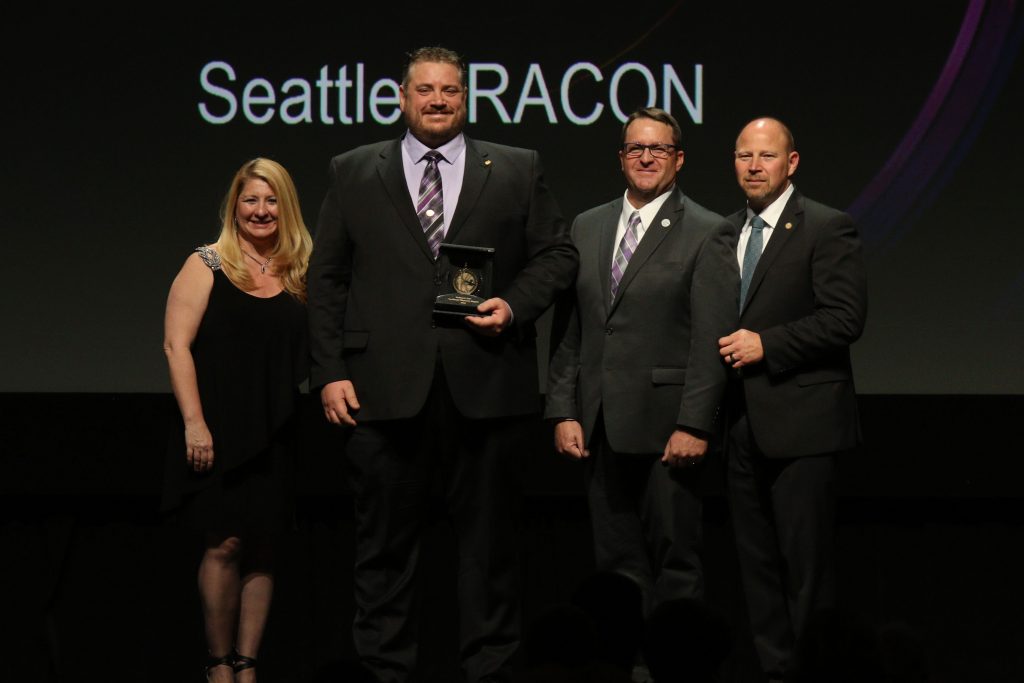
Joshua Pate had been a controller at S46 for about four years on Sept. 6, 2015, when he plugged into the departure east sector at S46. The east sector borders the 14,411-foot Mount Rainier and the Cascade Mountain Range.
The pilot of a Cessna departed Ranger Creek Airport and planned to follow the White River valley northwest towards lower terrain and eventually land at Boeing Field (BFI). The aircraft’s elevation at takeoff was 2,650 feet in the foothills just north of Mount Rainier. The cloud ceiling had been predicted at 5,000 feet that day but unfortunately, it was much lower. When the pilot turned the aircraft to follow the valley to the west, he encountered a wall of clouds and had no choice but to enter them.
N740QR: I’m lost in the clouds in the mountains and a VFR pilot.
Pate: Verify your full call sign please.
N740QR: N704QR.
Pate: Cessna N740QR squawk 0-3-3-4.
N740QR: 0-3-3-4.
N740QR: Alright, help me.
The pilot relayed that he was at 5,900 feet. Pate pulled up his emergency obstruction video map (EOVM) map and saw that the aircraft was less than five miles north of a 6,400 foot elevation profile and seven miles west of another rise in terrain.
The average life expectancy of a VFR pilot lost in the clouds is 178 seconds. When an inexperienced pilot encounters unplanned instrument meteorological conditions (IMC), a physiological reaction occurs and they begin to sweat and lose orientation. As an experienced controller, Pate knew that the most important thing he could do was help the pilot establish a straight and level flight.
Pate: N0QR stop turn. Just fly straight now.
Pate: N0QR stop your turn and fly straight.
Pate: N0QR I am not receiving any response. Just stop your turn and fly straight.
N740QR: 4QR straight flight.
When the pilot informed him that he was having navigation issues, Josh immediately began issuing no-gyro vectors. The pilot began circling because of his disorientation and inability to get a sense of his direction without his instruments. Pate was able to calmly and reassuringly direct the aircraft into VFR conditions by issuing no gyro vectors for about six minutes — twice the length of time a VFR pilot can typically sustain IFR conditions — preventing a fatal accident.
Northwest Mountain RVP Douglas Pincock:
Joshua did an incredible job directing N740QR during this tense and stressful situation. The pilot was able to regain his composure and focus his attention on flying the plane because he knew that a skilled and knowledgeable controller was guiding him safely through high terrain to VFR conditions. Joshua’s calm and steady direction saved the life of this pilot and his passenger. I am extremely proud to represent such a skilled and dedicated professional.
BELOW: Watch the award presentation.
BELOW: Watch and listen to highlights from this save event.
Southern Region: Donald Blatnik and Kenneth Scheele, Orlando TRACON
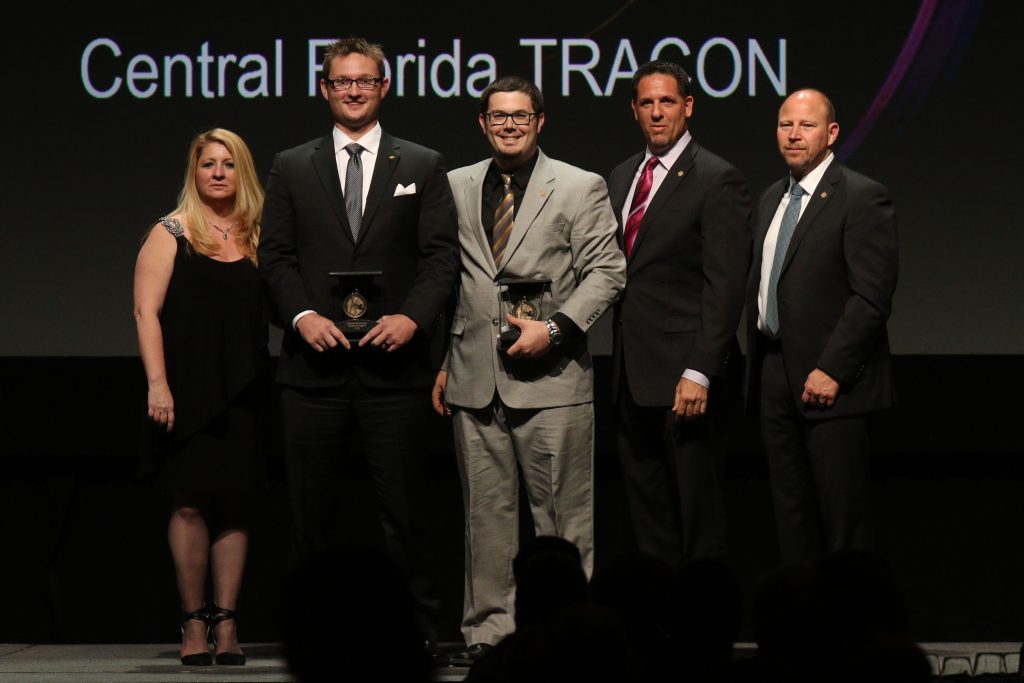
It was a busy push on April 18, 2015, when Donald Blatnik was training Kenneth Scheele on East Departure at Central Florida TRACON (F11). During this training session the pilot of a Cessna 400 suddenly reported low engine pressure and requested to land at the nearest airport.
N400BZ: Daytona, 0BZ, I got an issue with my engine right now, I’m not declaring an emergency or anything like that but I need to get direct to Kilo Tango India X-ray immediately for 0BZ.
Blatnik immediately took over the position and frequency in order to assist the struggling aircraft. The pilot reported that his engine and oil pressure were rapidly worsening and that he needed to get as low as possible. Blatnik continued to work the numerous other aircraft in his saturated airspace and began to direct them out of the aircraft’s way. Blatnik was updating the pilot with the location of nearby aircraft and the distance to the nearest airport, Space Coast Regional Airport (TIX), when the pilot declared an emergency.
Blatnik: 0BZ traffic’s now two o’clock and two miles westbound four-thousand 500 a Cirrus, let me know if you pick him up.
N400BZ: 0BZ is losing his engine – I need, I need the runway, 0BZ, declaring emergency.
Blatnik: 0BZ roger. Cleared visual approach, I’m just letting you know there’s traffic there. Cleared visual approach runway 2-7.
Blatnik continued to relay important information to the struggling pilot. Scheele coordinated a descent path with the controller in charge of the lower airspace, directing all aircraft away from the Cessna. Scheele also coordinated with the tower at TIX to ensure there would be no other traffic in the aircraft’s path.
In emergency situations, it is nearly impossible to predict how quickly an aircraft will descend. Blatnik and Scheele knew that quickly moving all aircraft out of the way was crucial to the safety of the pilot and everyone in the airspace. The pilot was beginning to sound frantic. Then he stopped responding for a few seconds.
Blatnik: N0BZ cleared to land any runway.
Blatnik: N0BZ cleared to land any runway, Space Coast Airport.
N400BZ: 0BZ.
As the aircraft rapidly descended, the pilot alerted Blatnik that he had lost an engine. Blatnik was able to give immediate clearance to the pilot in distress through his ability to quickly and effectively move nearby aircraft around without error or incident. Blatnik cleared the Cessna for visual approach to TIX and the aircraft landed safely, but then caught fire on the runway shortly after the pilot safely exited the aircraft.
Southern RVP Jim Marinitti:
Air traffic controllers work in an environment where we are expected to be right 100 percent of the time. There are no do-overs in a situation like this. Donald and Kenneth stepped up on the spot, during a busy session, without missing a beat. Without their fast actions, there is a possibility the pilot and his passengers would not have made it to the ground and out of the aircraft in time. Their actions represent the professionalism, teamwork, and bond that holds the National Airspace System together.
BELOW: Watch the award presentation.
BELOW: Watch and listen to highlights from this save event.
WATCH: Media coverage from WOFL-TV Fox Orlando.
Southwest Region: Wade Martin and Nick Valadez, Dallas Love Field
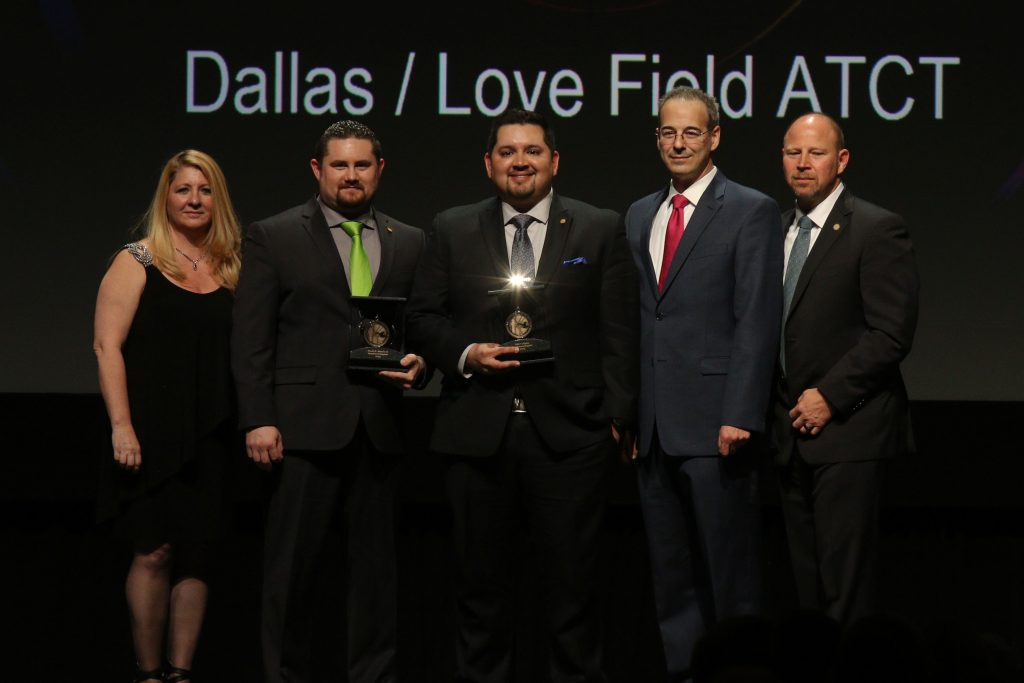
Late at night on Oct. 11, 2015, weather was clear at Dallas/Love Field (DAL) with normal departure traffic. The pilot of a Piper Lance had a clear takeoff from runway 13, but shortly after liftoff, the aircraft suffered a complete electrical failure. The pilot failed to respond to calls to adjust departure course and the transponder reply was never seen. He dialed 911 from his personal cell phone in an attempt to communicate with the tower, but the call dropped. The quick-thinking 911 dispatcher called the tower and informed the controllers on duty that a pilot in an emergency situation had attempted to call them. When the pilot called 911 again, the dispatcher patched him through to the tower where Wade H. Martin IV and Nick Valadez were working.
911 Dispatch: This is Stephanie with 9-1-1. I have the pilot that was having the electrical issues and couldn’t land. I have him on the line.
Martin: Please connect him.
911 Dispatch: OK. Just a moment.
N4432B: Hello?
Martin: Hey, can you hear me?
N4432B: Barely.
Martin spoke to the pilot and arranged for a low approach fly-by with runway lights turned all the way up so the pilot could make better visual contact with the airport and to establish if the aircraft’s landing gear was down. Because the aircraft had suffered a complete electrical failure, the pilot had no indication if the landing gear was down or locked. Controller Nick Valadez took over all frequencies and all aircraft on the ground so Martin could focus on assisting the pilot.
The Dallas Stars hockey team happened to be waiting to park at the airport in a Boeing 757, and a King Air aircraft was waiting to depart. An airport operations vehicle was also on the tarmac. Valadez asked the two aircraft and the airport operations vehicle to look up at the Piper to check its landing gear status. All three reported that the landing gear was down, which Martin relayed to the pilot. The Aircraft Rescue and Fire Fighting (ARFF) vehicles went from Alert I (standby) to Alert II (difficult or crash landing expected) near the runway. The pilot flew a left traffic pattern and indicated he would conduct a “deadstick landing” – when an aircraft loses all of its propulsive power and is forced to land without engine power.
N4432B: Yeah. I am going to come back around. I will land with the engine off just in case the gear is not locked.
Martin: Not a problem. I’m going to roll the fire equipment now.
Martin to Valadez: Roll ‘em.
N4432B: If the gear is locked, I’d like to get out and check it. If it’s good, I’ll taxi it back over to the FBO.
The gear remained down on landing and the pilot came to a stop within the first 1,700 feet of the 7,752-foot runway. The airport operations vehicle reported to Martin and Valadez that the aircraft had landed and was at a complete stop.
Southwest RVP Andrew LeBovidge:
The teamwork and calm resourcefulness demonstrated by Wade and Nick during this crisis truly exemplify the commitment to safety and service that is the hallmark of our profession. The fast and effective coordination between both Wade and Nick to establish how the plane should attempt to land ensured a safe outcome for the pilot. The manner in which Wade and Nick engaged to assist a pilot in distress is the epitome of the professionalism and dedication all controllers have to the system and the flying public.
BELOW: Watch the award presentation.
BELOW: Watch and listen to highlights from this save event.
WATCH: Media coverage from NBC Dallas-Fort Worth.
Western Pacific Region: William Hoppe, Ryan Nines, and Luis Ramirez, Northern California TRACON

Ryan Nines, William L. Hoppe Jr., and Luis Ramirez were all controllers on duty when a Cessna 182 departed runway 28 from Monterey Regional Airport (MRY) and headed towards Lincoln Regional Airport (LHM) on Nov. 18, 2015. Nines was on position when the aircraft hit 4,500 feet and the pilot stated that he was experiencing a rough ride and requested to return to MRY. Suddenly, the aircraft’s altitude dropped to 1,800 feet. It was descending tail-first in a dangerous spiraling turn.
Nines: N5188T, NorCal approach, are you alright there?
N5188T: Uh, no I’m getting…
Nines: N5188T try to level your wings, just level your wings. I’m getting a low altitude alert, check your altitude immediately. The minimum vectoring altitude in that area is two thousand, three hundred.
Nines continued to advise the pilot to level his wings. During these transmissions, aircraft on the same frequency became aware that this pilot was in danger. An unknown pilot began to advise the Cessna pilot to activate the autopilot if it was on board because it would assist him in keeping the wings level. The Cessna pilot was able to successfully turn on his autopilot but because of the nature of his equipment failures, this actually made flying the aircraft harder. The autopilot froze his equipment, making it near impossible to turn off the malfunctioning systems or their alert sirens.
Nines: N5188T I still show you’re in a turn there, are you, are you in a turn? Just level your wings, I don’t want you turning there because last time that you did that you ended up going down pretty quickly.
N5188T: Okay I got turned around, I am level, but I’m now turned around, headed uh, 3…3-1-0. Should I turn around?
Nines: N5188T right now I just want you to fly any heading with level wings. I don’t want you to make any type of turns.
N5188T: Fly level wings, keep climbing.
Nines, Hoppe Jr., and Ramirez worked well together to assist the nervous pilot. Nines advised him that turning during the climb was not necessary and was hindering his ability to maintain his flight heading. Hoppe Jr. and Ramirez began scouting out the weather at nearby airports and suggested Nines instruct the pilot to climb to visual flight rules conditions. Nines informed the pilot that nearby Castle Airport (MER) was reporting visual meteorological conditions (VMC). During this time, the aircraft experienced two more upsets and loss of altitude. Each time, Nines quickly determined that it involved an unintentional turn and instructed the pilot to cease rolling the aircraft. Thanks to the teamwork displayed by Nines, Hoppe Jr., and Ramirez, the pilot was eventually able to return to the ground safely.
Western Pacific RVP Ham Ghaffari:
The incredible work of Ryan, William, and Luis exemplifies the teamwork integral to air traffic control. During emergency situations every second matters. All hands were immediately on deck to ensure that the pilot and his two passengers got to the ground safely. The focus required to assist a pilot through nearly an hour of rough and unpredictable flight cannot be overstated. I am very proud to represent these dedicated professionals who bring the highest standard of safety to air traffic control every day.
BELOW: Watch the award presentation.
BELOW: Watch and listen to highlights from this save event.
President’s Award: Donald Blatnik III and Kenneth Scheele, Central Florida TRACON
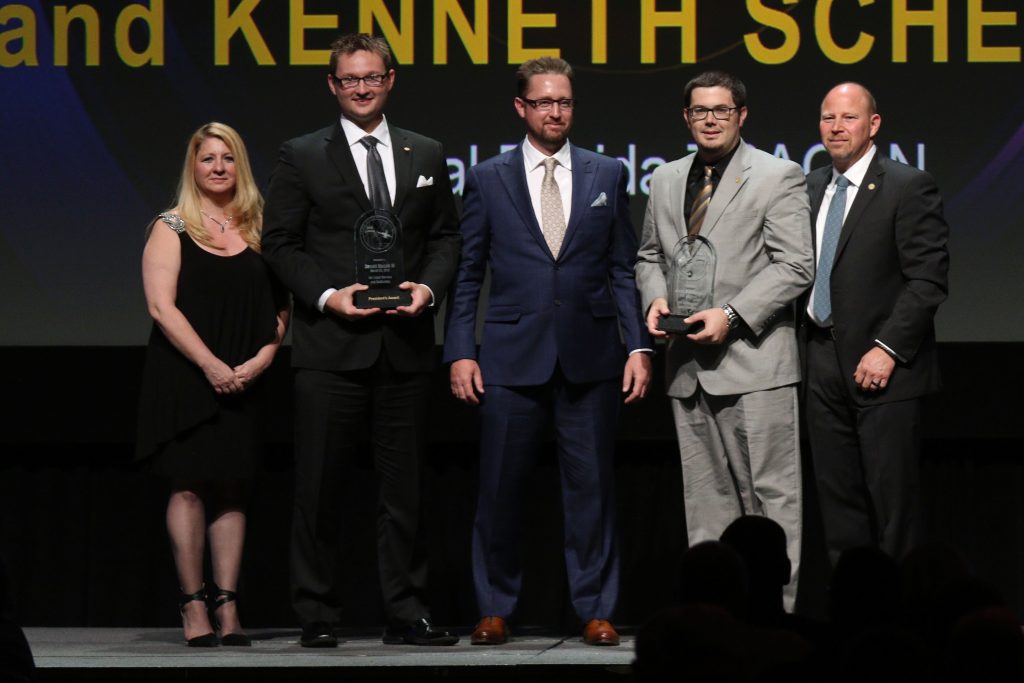
BELOW: Watch the award presentation.
BELOW: Watch and listen to highlights from this save event.
Honorable Mention
ALASKAN REGION
Justine Rockey, Anchorage Center (ZAN)
CENTRAL REGION
Kyle Kraft, James Meli, Kansas City Center (ZKC)
Robert “Keith” O’Connor, ZKC
EASTERN REGION
Shashi Adams, Roanoke ATCT (ROA)
John Gannon, New York Center (ZNY)
Glenn Garasic, Potomac TRACON (PCT)
GREAT LAKES REGION
Dwight Edgington, Chicago O’Hare ATCT (ORD)
Joseph Gramm, Joseph Daskalakis, Kristen Carlson, Indianapolis ATCT (IND)
Michael Gish, Chicago TRACON (C90)
David Hess, ORD
Marshall Penton, Travis Weisenberger, Jeff Hormann, Toledo ATCT (TOL)
Jeffrey Smith, John Davis, Justin Danz, Cleveland Center (ZOB)
Renee Spencer, Fort Wayne ATCT (FWA)
Brock Wishowski, C90
NEW ENGLAND REGION
Michael Anderson, Kyle Meeker, Bradley TRACON (Y90)
Kevin Davison, Bangor ATCT (BGR)
NORTHWEST MOUNTAIN REGION
Sean Michael Billet, Boise ATCT (BOI)
Jacques Mailloux, JC Webb, Rocky Mountain Metropolitan ATCT (BJC)
Andy Marosvari, BOI
Kari Miller, James Nau, Portland-Hillsboro ATCT (HIO)
Mitch Noltimier, Denver Center (ZDV)
Paul Ross, Kerry Allen, Jason Cruz, Matthew
Dippé, Seattle Center (ZSE)
Greg Stiles, Portland TRACON (P80)
Stuart Widman, Seattle TRACON (S46)
SOUTHERN REGION
Kodi Brookman, Johnathan Graves, Orlando ATCT (MCO)
Chris Cambridge, Jim Alcorn, Brian Paula,
Ricardo Martinez, Miami ATCT (MIA)
William Clark, Memphis Center (ZME)
Wayne Dombroski, Atlanta TRACON (A80)
Marc Doss, ZME
Thomas “TS” Eggar, Raleigh-Durham ATCT (RDU)
Timothy Homan, Jacksonville Center (ZJX)
Patrick Kearney, A80
Kelly McElrath, Jason Levins, Jonathan
Carmichael, ZME
David Messer, ZME
William “Randy” Miller, ZME
Aaron Rathburn, A80
Kevin Rogers, ZME
Mitch Stephens, Savannah ATCT (SAV)
Kathlene Verib, Cincinnati-Northern Kentucky ATCT (CVG)
Kristofer Violette, Louisville Standiford ATCT (SDF)
SOUTHWEST REGION
Scott Brewer, Albuquerque Center (ZAB)
Dave Bricker, Desiree Monsivaiz, ZAB
Grant Paladino, Shreveport ATCT (SHV)
Craig Phelan, Fort Worth Center (ZFW)
Cody Summers, Austin ATCT (AUS)
Steven Zepeda, Dayna Tillery, Houston TRACON (I90)
WESTERN PACIFIC REGION
Samirah Abdelfattah, Santa Monica ATCT (SMO)
Ashley Callen, Daniel Zickafoose, Las Vegas ATCT (LAS)
Steve Lam, San Gabriel Valley ATCT (EMT)
Zoem Patel, Maurice Pitts, Los Angeles ATCT (LAX)
Tom Phan, Oakland Center (ZOA)
Eric Sarbacker, Southern California TRACON (SCT)
Elizabeth Walker, Northern California TRACON (NCT)


